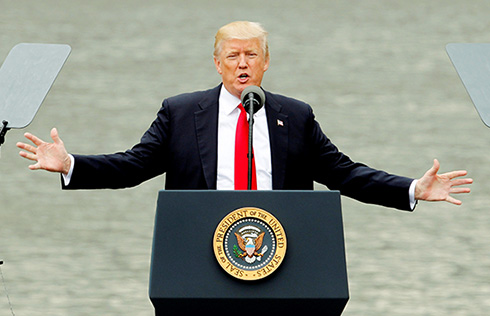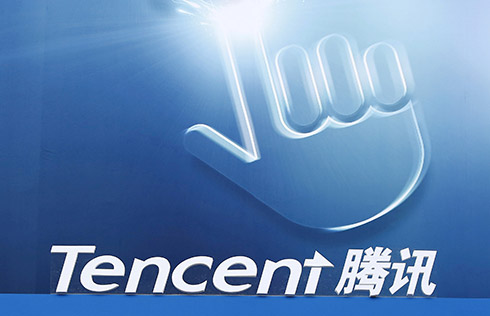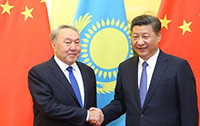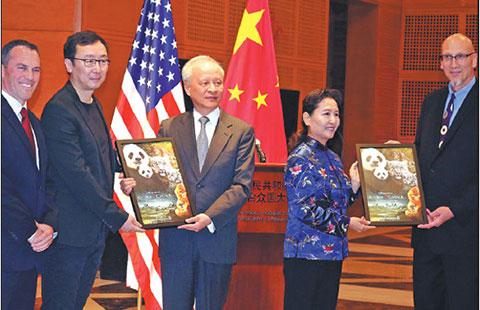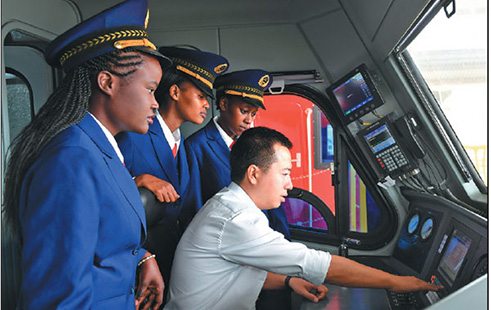11 facts you should know about the vision
The China-led development initiative aims to boost economic growth for all involved and promote a more balanced world order
1. The Belt and Road Initiative is not a modern version of the US' Marshall Plan.

Mei Xinyu, a researcher of international trade and economics at the Ministry of Commerce's Chinese Academy of International Trade and Economic Cooperation
China has no intention of challenging the current US-dominated global economic and political systems, and its Belt and Road Initiative - the Silk Road Economic Belt and the 21st Century Maritime Silk Road - is by no means comparable to the United States' Marshall Plan, which is considered, to some extent, to have led to the Cold War.
Although China is promoting a series of bilateral and regional free trade agreements, its objective is not similar to the British Empire's pre-World War II "Imperial Preference", and is not to create a world market parallel to that led by the US.
The US-led international financial system is unfair, but it is not in China's interest to change the system. More importantly, any drastic change in the system would create uncertainties and risks, which no economy wants.
China believes in reform, and it is optimistic about making the international financial system more efficient by supplementing the roles of the International Monetary Fund, the World Bank and the Asian Development Bank. It knows that only a multilateral trade system can meet its demand for an expanding global market, which is why it has an open mind on many Western-dominated international trade arrangements, while the Asian Infrastructure Investment Bank will take an inclusive approach to create an improved international financial system.

2. The initiative will be connected with the Eurasian Economic Union.

Djoomart Otorbaev, a distinguished professor at Beijing Normal University's Emerging Markets Institute and Tsinghua University's Schwarzman College, and a former prime minister of Kyrgyzstan
With the same aim as the Belt and Road Initiative, the Eurasian Economic Union was formed in 2015 as a purely economic union, which currently includes five countries. The EEU aims to break barriers to market access in the five member nations and further deepen economic cooperation within an integrated single market of 183 million people.
To meet the expectations of the leaders of China and Russia - who are the pioneers of the Belt and Road Initiative and the EEU respectively - the two initiatives should find ways to integrate, based on natural geographic peculiarities and complementary advantages. We need to meet each other more regularly to research how to harmonize the bilateral procedures that already exist between China and members of the EEU.
The Chinese leadership is persuasive and expectant in its commitment to the success of this initiative, and things will move in the right direction with financial and human resources, and knowledge.
Facing a large international community, China needs to learn how to do things in the right way given its long and rich, but mainly inward-oriented, history, and to accept its leadership role.
The initiative, linking China to Eurasia and Europe, is not at all only about infrastructure, but also about soft power and advancing the understanding of different people and countries along the two ancient trade routes. It's not a traditional bilateral system, but a truly regional, multinational, multilateral network and thus, it needs to be designed with precision.

3. The initiative brings a new mindset to global economic governance.

Liang Haiming, chief economist at the China Silk Road iValley Research Institute
Despite the recovering US economy, Washington under the watch of US President Donald Trump is poised to accord priority to economic issues at home, rather than abroad. That, to some extent, means Beijing is required to propose a plan to address the economic woes haunting many other countries.
The implementation of the Belt and Road Initiative is a boon to sluggish global growth. It is conducive to expanding global demand and revitalizing global growth, marking a breakthrough in both China's interaction with other economies and global economic governance.
In particular, China's proposal to explore third-party market cooperation could bring benefits to Western nations and developing countries along the Belt and Road, without causing a clash of interests. Projects involving China, France and some French-speaking African countries are a case in point.
For emerging economies, the initiative means more investment and bilateral trade deals, which may grant them greater economic sway. For countries that are less industrialized and heavily reliant on manufacturing, China's financial and technological assistance following its Belt and Road projects will be of great value.
4. The inclusive initiative will provide opportunities for other developing countries.

Wang Yiwei, a professor of international relations at Renmin University of China
Next month, China will hold a high-level international cooperation forum on the Belt and Road Initiative that will focus on global recovery, rebalancing, renovation and reconnection in response to rising concerns about global governance. Proposed in 2013 and unlike traditional globalization backed by tariff reductions, the initiative is aimed at improving connectivity between regions and boosting global growth through infrastructure construction, among other things.
The initiative, which focuses on Eurasian infrastructure and better land and sea connectivity, is expected to elevate 3 billion people to middle class status by 2050 and help increase global trade by $2.5 trillion in the next decade.
There is good reason to believe that the initiative can hit its targets, because every $1 increase in infrastructure investment in developing economies can raise their imports by $7 US cents, half of which comes from developed countries, as Justin Yifu Lin, former vice-president of the World Bank, has said. In other words, the West, too, can benefit from an increase in exports as the initiative stimulates global infrastructure investment.

5. The early harvests of the initiative are of great significance.

Zhang Fei, an associate researcher at the Ministry of Commerce's Chinese Academy of International Trade and Economic Cooperation
More than 100 countries and international organizations have become part of the China-led Belt and Road Initiative, and more than 30 countries along the two routes have signed cooperative agreements with China. The initiative has also won the approval of important economic blocs, such as the European Union and the Association of Southeast Asian Nations, while a number of member nations of the two blocs have signed trade and investment agreements with China. Moreover, a United Nations resolution on Afghanistan, passed three months ago, voiced vocal support for the initiative, encouraging all UN members to participate to revive the war-stricken country's economy.
Last year alone, Chinese enterprises invested at least $14.5 billion in markets that make up the network that connects Asia, Europe and Africa, and covers more than 60 countries and regions with a total population of about 4.4 billion. It has also set up 65 trade cooperation zones along the way.
These achievements would not have been possible without the support of local governments and enterprises, which is evidence that the Belt and Road projects can live up to their inclusive and reciprocal nature. Although most of the projects are related to infrastructure connectivity, meaning considerable funds are often needed to start them and making profits can take some years, participating enterprises, particularly those in the West, can grab a decent share of the profits, if they play along.

6. The initiative will help China better address the new normal in economic development.
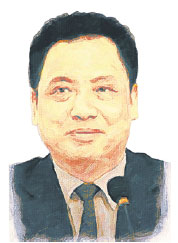
Xue Li, a senior research fellow at the Chinese Academy of Social Sciences' Institute of World Economics and Politics
The Belt and Road Initiative is in line with efforts to facilitate China's economic transformation. Chinese enterprises are seeking to leave the lower end of global value chains and manufacture more high-value-added products. A rise in labor costs and excessive capacity will inevitably drive Chinese companies to explore markets in neighboring countries, which also welcome China's assistance, for instance, in infrastructure.
It can be challenging to persuade labor-intensive private enterprises to venture across borders, as their founders, who are often aging but still in charge, find it less appealing to explore overseas markets. But it is a step that has to be made considering the economic transitions, and the initiative could present game-changing opportunities.
By placing underdeveloped western Chinese provinces and regions at the forefront of the process of opening-up, the initiative also has great potential to narrow the development gap between China's east and west.

7. The initiative will help boost international energy cooperation.

Shamshad Akhtar, an undersecretary-general of the United Nations and executive secretary of the UN Economic and Social Commission for Asia and the Pacific
The Belt and Road Initiative will generate mutual benefits for China and its partners. However, the economic, social and environmental costs and benefits vary across borders, depending on the terrain, stage of development, production capacities and traffic flows.
With nearly two-thirds of Belt and Road countries facing energy deficits, the initiative needs to complement and supplement subregional energy connectivity initiatives. There is huge scope to develop power grids; promote smart, green and integrated power and gas markets; and extend cross-border gas and oil pipelines from resource-rich Central Asia to South and East Asia. Drawing on the initiatives of China's State Grid and the Global Energy Interconnection Development Cooperation Organization to promote global energy interconnections will help to enhance the region's energy security and improve access to sustainable energy.

8. The initiative will kick-start a new era in global interconnectivity.

At the core of the Belt and Road Initiative is interconnectivity, which has multiple implications for all parties concerned. On the economic front, it stresses the importance of win-win cooperation and bringing tangible dividends to the international community. The projects on cross-region connectivity, trade exchanges and capacity cooperation are aimed at expanding demand and thus rebalancing the global economy.
This bodes well for Belt and Road countries in pursuit of advanced industrialization and modernization, as well as better infrastructure, against a backdrop of uncertain global growth.
Zhao Lei, a professor at the Party School of the Communist Party of China Central Committee
Aimed at shared development of all countries involved, the initiative is also about providing public goods and optimizing global governance. China is more than willing to offer tangible, ideological and institutional public goods to the international community. It has not only helped other developing economies with infrastructure construction, but also endeavored to institutionalize its endorsement of extensive interconnectivity, which is poised to provide more inclusivity than the Western-led elite clubs.

9. The initiative sets the tone for China's inclusive and cooperative foreign policy.

Wang Zhimin, a professor at the University of International Business and Economics in Beijing
China's approach to the Belt and Road Initiative mirrors its independent, nonaligned diplomatic stance. As a longtime opponent of a winner-takes-all philosophy, China signed memorandums of understanding and agreements with at least 56 countries and regional organizations last year, covering both developed and developing communities.
The inclusive and open nature of the initiative could supplement the existing international order. Old multinational organizations, including the World Bank and the Asian Development Bank, have played their parts, but many of them do not pay enough attention to the need for infrastructure in the developing world.
The Asian Infrastructure Investment Bank, for one, is designed to resolve the problem. Other Beijing-proposed financing institutions, such as the New Development Bank, will not only bring new business opportunities to other economies, but also prop up the overseas operations of Belt and Road projects.
The implementation of the initiative is conducive to enhancing infrastructure worldwide, boosting developing countries' production and consumption, and striking a balance between virtual and bricks-and-mortar economies. It aims to replace hegemonism and power politics, and help forge fairer global governance.

10. The initiative has huge support from the international community.

Chu Yin, an associate professor at the University of International Relations and a research fellow at the Center for China and Globalization
The past year saw major Belt and Road projects making huge progress and beginning to pay dividends for countries along the two routes. With a capacity of 50 megawatts and an annual average power generation of about 317 gigawatt-hours, the Upper Marsyangdi A Hydropower Station, the first hydroelectric project built in Nepal by a Chinese enterprise - Power Construction Corp of China - has been put into operation.
The Addis Ababa-Djibouti Railway, which connects the capital cities of Ethiopia and Djibouti, and was inaugurated two months ago, is Africa's first cross-border standard gauge rail line as well as the first railway outside of China to be built in line with Chinese standards, using Chinese technology and equipment. Such projects are a boon for countries with underdeveloped infrastructure and have great potential to increase employment and economic growth.
Moreover, an increasing number of Chinese enterprises, including private ones, are willing to explore overseas markets covered by the Belt and Road Initiative. Their increasingly active participation further promotes the initiative. As a result, more countries along the routes are now willing to cooperate with Chinese companies, adding more weight to China's role as a leader in global governance.
The Addis Ababa-Djibouti Railway, for instance, is a game-changer in the eyes of some local officials, because it reinforces the development of industrial parks, special economic zones and other industrial chains along the way. Countries such as Cambodia, Laos and Myanmar have experienced the same changes through similar cooperation in the past three years. The initiative will produce both tangible and intangible benefits to safeguard peaceful development and recalibrate the world order in a fairer, more reasonable direction.

11. The initiative will help spread China's soft power abroad.

Liang Yabin, senior researcher at the Pangoal Institution and an associate professor at the Party School of the Communist Party of China Central Committee
For historical and ideological reasons, there have been many attempts to play up the so-called China threat, casting a shadow over China's peaceful development and even fueling concerns about the Belt and Road Initiative. It is vital that Beijing translates its soft power into a language that can be understood by the rest of the world, like the "lean, clean and green" governance championed by the AIIB.
To carry out its Belt and Road ambitions, China needs to disseminate its geopolitical perspective to relevant countries. China should make it clear that the pursuit of the transnational initiative go beyond ideological and cultural differences, and that its peaceful rise will not come at the cost of other countries' interests.
Translating the Chinese narrative of shared development into a universal language is a viable solution to geopolitical misunderstandings and will expedite the promotion of the initiative.






